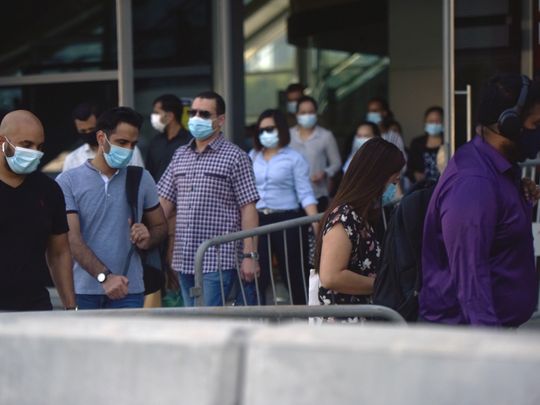
Abu Dhabi: The UAE has emphatically stressed the need to wear masks and maintain social distancing in order to limit the COVID-19 outbreak.
Today, the importance of these precautions was highlighted once again when the United States Centres of Disease Control (CDC) confirmed that the novel coronavirus responsible for COVID-10 can be transmitted airborne, and can infect people who are more than metres apart.
This kind of airborne transmission mostly happens indoors, in areas with poor ventilation, the American public health institute said on updates about COVID-19 on its website. However, in most cases, “COVID-19 is thought to spread mainly through close contact from person to person, including between people who are physically near each other, i.e., within two metres”, the CDC added.
“People who are infected but do not show symptoms [i.e., asymptomatic patients] can also spread the virus to others. We are still learning about how the virus spreads and the severity of illness it causes,” the CDC added.
Read More
- Watch: In this Sharjah school, you don’t have to go only to the bathroom to wash your hands amid COVID-19
- News in pictures: Saudi Arabia at EXPO 2020 Dubai, sea temperature rises, Raina hails Dhoni, Chinese vlogger burned, Modi opens tunnel, gang-raped woman commits suicide in India, witch hunt, Trump on COVID...
- COVID-19: UAE reports 3 deaths, 1,181 new coronavirus cases
The UAE has recently been reporting about 1,000 new cases of COVID-19 a day. Last week, Saif Al-Dhaheri, a spokesperson for the National Authority for Emergency, Crisis and Disaster Management (NCEMA), said that authorities have intensified control and inspection campaigns, issuing violations against individuals and institutions that do not comply with preventive measures.
Al Dhaheri also mentioned that a failure to wear masks continues to be the most commonly neglected safety measure. In light of the CDC’s reports on airborne transmission, this kind of negligence can be especially risky.
On its website, the CDC updated the various known means of COVID-19 transmission.
Person-to-person
According to the CDC, COVID-19 spreads very easily from person to person. However, how easily a virus spreads from person to person can vary. Sars-CoV-2, which causes COVID-19, appears to spread more efficiently than influenza viruses. However, the virus is not as efficient at spreading as the measles virus, the most contagious viruses known to affect people.
Close contact
COVID-19 transmission is most common when people are in close contact. People who are physically near — within two metres — of a person with COVID-19, or have direct contact with that person, are at greatest risk of infection.
When people with COVID-19 cough, sneeze, sing, talk, or breathe they produce respiratory droplets, the CDC explained. These droplets can range in size from larger droplets, some of which are visible, to smaller droplets. Small droplets can also form particles when they dry very quickly in the airstream.
Infections occur mainly through exposure to respiratory droplets when a person is in close contact with someone who has COVID-19. Respiratory droplets cause infection when they are inhaled or deposited on mucous membranes, such as those that line the inside of the nose and mouth.
As the respiratory droplets travel further from the person with COVID-19, the concentration of these droplets decreases. Larger droplets fall out of the air due to gravity. Smaller droplets and particles spread apart in the air. With passing time, the amount of infectious virus in respiratory droplets also decreases.
Airborne transmission
COVID-19 can sometimes be spread by airborne transmission. Some infections can be spread by exposure to virus in small droplets and particles that can linger in the air for minutes to hours. These viruses may be able to infect people who are further than two metes away from the person who is infected, or after that person has left the space.
This kind of spread, airborne transmission, is an important way that infections like tuberculosis, measles, and chickenpox are spread. There is evidence that under certain conditions, people with COVID-19 seem to have infected others who were more than two metres away. These transmissions occurred within enclosed spaces that had inadequate ventilation. Sometimes the infected person was breathing heavily, for example while singing or exercising.
Under these circumstances, scientists believe that the amount of infectious smaller droplet and particles produced by the people with COVID-19 became concentrated enough to spread the virus to other people. The people who were infected were in the same space during the same time, or shortly after the person with COVID-19 had left.
The CDC however stressed that available data indicates that it is much more common for the coronavirus to spread through close contact with a person who has COVID-19 than through airborne transmission.
Through contaminated surfaces
COVID-19 can also spread through contact with contaminated surfaces, but this occurs less commonly. This happens when respiratory droplets land on surfaces and objects. A person who touches the contaminated surface or object can then get COVID-19 if they then touch their own mouth, mose or eyes. However, the CDC does not believe that this kind of COVID-19 spread is very common.
Between people and animals
The infectious disease can be transmitted between people and animals, but this kind of spread is rare, and only occurs in some situations.
According to the CDC, it is aware of a small number of pets worldwide, including cats and dogs, reported to be infected with Sars-CoV-2, mostly after close contact with people with COVID-19. However, the authority added that the risk of COVID-19 spreading from animals to people is considered to be low.
How to protect yourself from COVID-19
*The best way to prevent illness is to avoid being exposed to this virus. You can take steps to slow the spread.
*Stay at least two metres away from others, whenever possible. This is very important in preventing the spread of COVID-19.
*Cover your mouth and nose with a mask when around others. This helps reduce the risk of spread both by close contact and by airborne transmission.
*Wash your hands often with soap and water. If soap and water are not available, use a hand sanitiser that contains at least 60 per cent alcohol.
*Avoid crowded indoor spaces and ensure that indoor spaces are properly ventilated by bringing in outdoor air as much as possible. In general, being outdoors and in spaces with good ventilation reduces the risk of exposure to infectious respiratory droplets.
*If you are sick, stay home and isolate from others. Also, clean and disinfect frequently-touched surfaces routinely.
*Maintain social connections and pay attention to your mental health, as pandemics can be stressful.
Source: Centres for Disease Control











